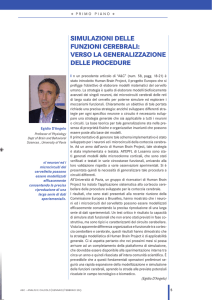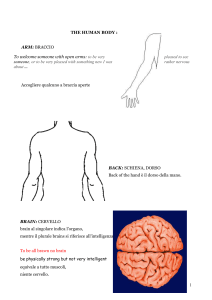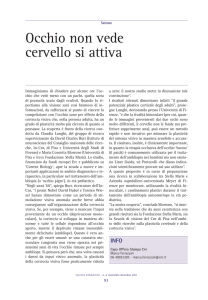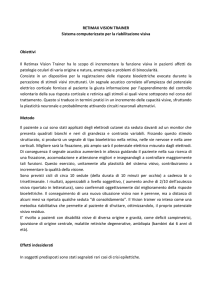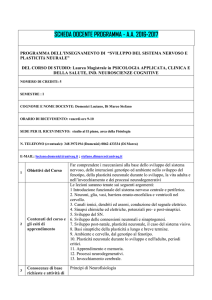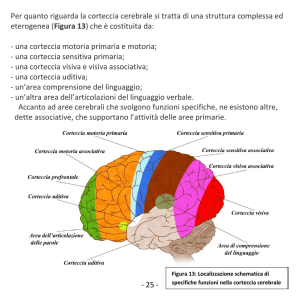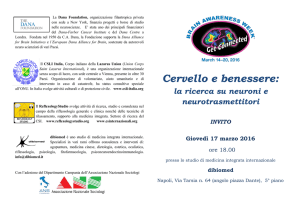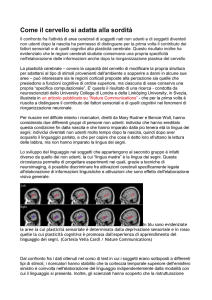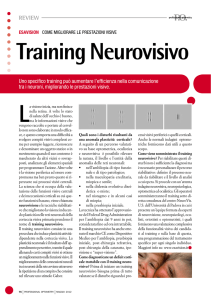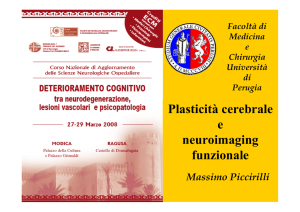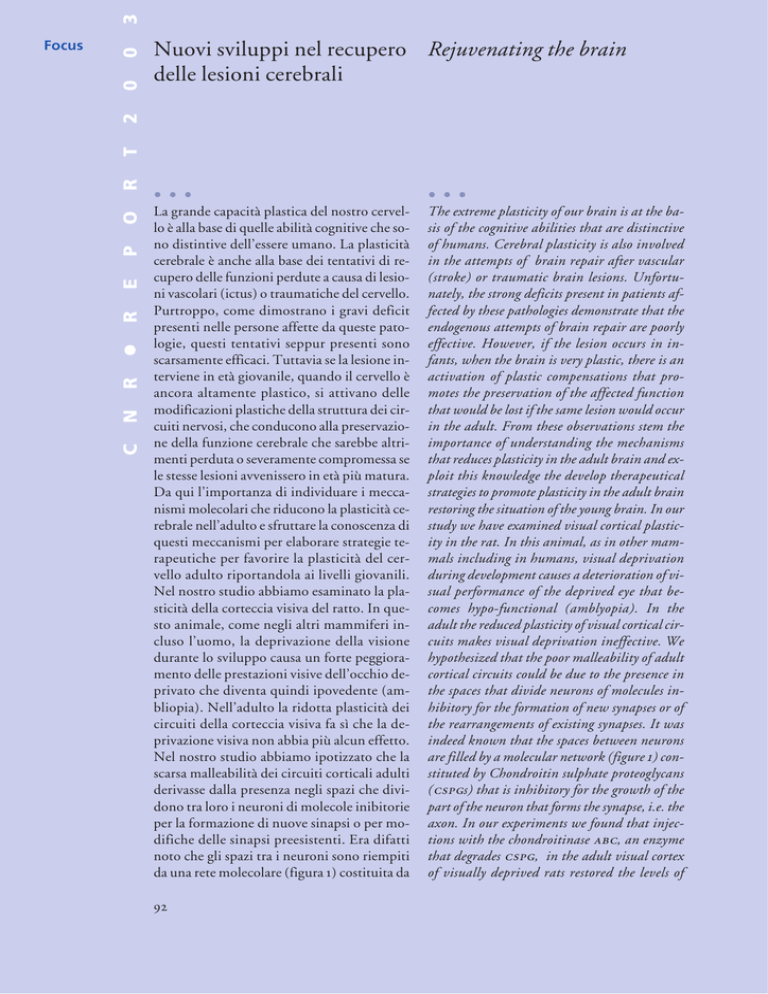
3
0
0
T
2
Nuovi sviluppi nel recupero Rejuvenating the brain
delle lesioni cerebrali
R
O
P
E
R
R
N
C
Focus
La grande capacità plastica del nostro cervello è alla base di quelle abilità cognitive che sono distintive dell’essere umano. La plasticità
cerebrale è anche alla base dei tentativi di recupero delle funzioni perdute a causa di lesioni vascolari (ictus) o traumatiche del cervello.
Purtroppo, come dimostrano i gravi deficit
presenti nelle persone affette da queste patologie, questi tentativi seppur presenti sono
scarsamente efficaci. Tuttavia se la lesione interviene in età giovanile, quando il cervello è
ancora altamente plastico, si attivano delle
modificazioni plastiche della struttura dei circuiti nervosi, che conducono alla preservazione della funzione cerebrale che sarebbe altrimenti perduta o severamente compromessa se
le stesse lesioni avvenissero in età più matura.
Da qui l’importanza di individuare i meccanismi molecolari che riducono la plasticità cerebrale nell’adulto e sfruttare la conoscenza di
questi meccanismi per elaborare strategie terapeutiche per favorire la plasticità del cervello adulto riportandola ai livelli giovanili.
Nel nostro studio abbiamo esaminato la plasticità della corteccia visiva del ratto. In questo animale, come negli altri mammiferi incluso l’uomo, la deprivazione della visione
durante lo sviluppo causa un forte peggioramento delle prestazioni visive dell’occhio deprivato che diventa quindi ipovedente (ambliopia). Nell’adulto la ridotta plasticità dei
circuiti della corteccia visiva fa sì che la deprivazione visiva non abbia più alcun effetto.
Nel nostro studio abbiamo ipotizzato che la
scarsa malleabilità dei circuiti corticali adulti
derivasse dalla presenza negli spazi che dividono tra loro i neuroni di molecole inibitorie
per la formazione di nuove sinapsi o per modifiche delle sinapsi preesistenti. Era difatti
noto che gli spazi tra i neuroni sono riempiti
da una rete molecolare (figura 1) costituita da
92
The extreme plasticity of our brain is at the basis of the cognitive abilities that are distinctive
of humans. Cerebral plasticity is also involved
in the attempts of brain repair after vascular
(stroke) or traumatic brain lesions. Unfortunately, the strong deficits present in patients affected by these pathologies demonstrate that the
endogenous attempts of brain repair are poorly
effective. However, if the lesion occurs in infants, when the brain is very plastic, there is an
activation of plastic compensations that promotes the preservation of the affected function
that would be lost if the same lesion would occur
in the adult. From these observations stem the
importance of understanding the mechanisms
that reduces plasticity in the adult brain and exploit this knowledge the develop therapeutical
strategies to promote plasticity in the adult brain
restoring the situation of the young brain. In our
study we have examined visual cortical plasticity in the rat. In this animal, as in other mammals including in humans, visual deprivation
during development causes a deterioration of visual performance of the deprived eye that becomes hypo-functional (amblyopia). In the
adult the reduced plasticity of visual cortical circuits makes visual deprivation ineffective. We
hypothesized that the poor malleability of adult
cortical circuits could be due to the presence in
the spaces that divide neurons of molecules inhibitory for the formation of new synapses or of
the rearrangements of existing synapses. It was
indeed known that the spaces between neurons
are filled by a molecular network (figure 1) constituted by Chondroitin sulphate proteoglycans
(cspgs) that is inhibitory for the growth of the
part of the neuron that forms the synapse, i.e. the
axon. In our experiments we found that injections with the chondroitinase abc, an enzyme
that degrades cspg, in the adult visual cortex
of visually deprived rats restored the levels of
3
{1}
Visualizzazione della rete molecolare che avvolge i neuroni
corticali adulti inibendo la plasticità delle connessioni nervose.
Visualization of the molecular net that ensheaths adult cortical
neurons and inhibits plasticity of neural connections
0
Focus
R
O
P
E
R
R
N
C
Rejuvenating
the brain
T
2
0
Nuovi sviluppi
nel recupero
delle lesioni
cerebrali
{1}
Condroitinsolfati proteoglicani (cspg) inibitoria per la crescita della parte del neurone
che forma la sinapsi con i neuroni bersaglio e
cioè l’assone. Nei nostri esperimenti abbiamo
verificato che iniettando condroitinasi abc,
un enzima batterico che degrada i cspg, nella corteccia visiva adulta di animali deprivati
visivamente si ripristinavano i livelli di plasticità tipici della corteccia del giovane. Questo studio individua quindi una categoria di
molecole, i cspg, che potrebbero essere aggrediti farmacologicamente in modo da riportare la plasticità della corteccia visiva ai livelli del giovane. Dato che i cspg sono presenti in varie aree del cervello è possibile che
la rimozione dei cspg ripristini i livelli giovanili di plasticità cerebrale non solo nella
corteccia visiva ma anche in altre strutture cerebrali. Studi futuri dimostreranno se la rimozione dei cspg faciliterà fenomeni di recupero funzionale non solo dall’ambliopia,
ma anche da lesioni cerebrali.
cnr
Istituto di neuroscienze
93
plasticity typical of the young cortex. Our study
individuates a class of molecules, the cspg, that
could be targeted pharmacologically to reactivate in the adult cortex the levels of plasticity
typical of the young animal. cspgs are present
in several brain structures suggesting that cspg
removal could reinstall the levels of plasticity of
the young not only in the visual cortex, but also
in other brain areas. Future studies will show
whether targeting cspgs can facilitate the mechanisms of recovery not only from amblyopia, but
also from brain lesions.
cnr
Institute of Neuroscience

